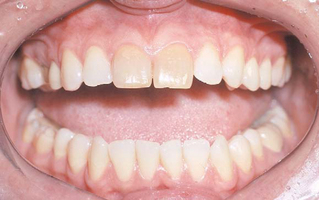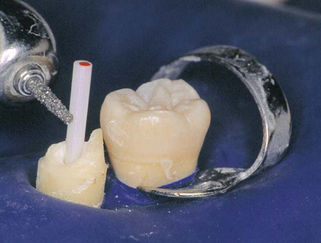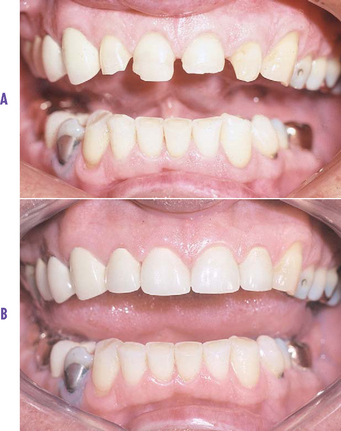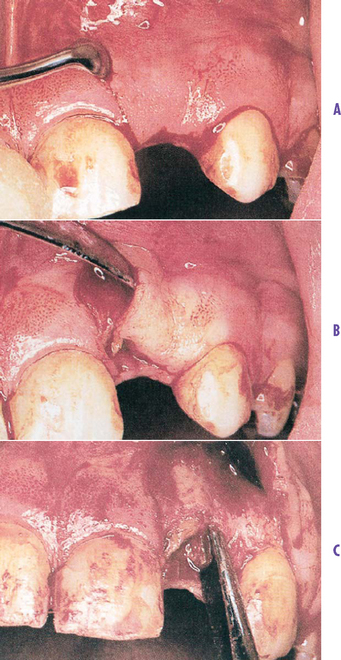CHAPTER 2 Divisions in Dentistry
Types of Dentists
Many people believe that all dentists perform every aspect of dentistry. Although some general dentists provide most categories of oral services, most dentists refer patients to specialized dentists for specific treatment that they do not perform themselves. In this chapter you will learn about the various types of dentists and the services they provide. You will be able to identify the areas of dentistry that have specialists with extra education, and those that do not have specialists. Also, your vocabulary will increase, allowing you to better understand the subsequent chapters in this book.
SPECIALTIES
1. Endodontics (see Chapter 7)
An endodontist completes at least 2 years of postdoctoral education specializing in endodontics. This area of dentistry includes treatment of teeth with diseased pulp tissue (FIG. 2.1). The inside of a tooth, called the dental pulp, is often referred to as the nerve. The pulp includes nerve tissue, blood vessels, connective tissue, and tooth regenerative cells.
Pain relief is provided by having the general dentist or endodontist perform root canal therapy. Teeth usually contain one to four (and occasionally more) root canals (FIG. 2.2). A small hole is made through the top of the tooth or crown (cap) into the dental pulp, and the diseased pulp is removed. A piece of rubberlike material called gutta-percha is inserted in place of the pulp. It is cemented into the tooth with a sealant to medicate the tissue at the deepest end of the dental pulp, where it exits from the tooth into the jawbone. Other types of materials may be used to fill root canals, including various pastes and metallic or plastic reinforcements.
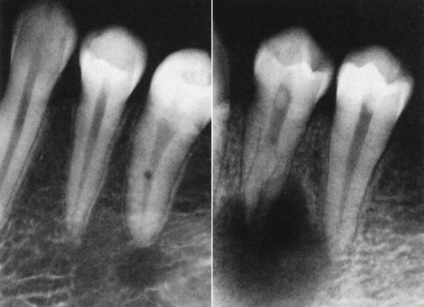
FIG. 2.2 The gray internal chambers in each tooth are root canals that house the dental pulp.
(From Cohen S, Burns RC: Pathways of the pulp, ed 6, St Louis, 1994, Mosby.)
After the dental pulp has been removed and the remaining root canal filled, a metallic, ceramic, carbon, or fiber post (FIG. 2.3) may be cemented into the tooth to connect the weakened top portion (crown) of the tooth with the now hollow root.
Root canal therapy is successful in more than 95% of cases but occasionally, root canal–treated teeth are still painful. This problem is discussed in detail in Chapter 7.
Occasionally the tooth root end, deep in the bone, becomes infected in a root canal–treated tooth and requires further therapy, called an apicoectomy. In this situation a small incision is made in the gum over the root end of the tooth. Any diseased tissue is removed, and a filling is placed in the root end. The site is sutured for proper healing (see discussion of apicoectomy in Chapter 7, on p. 41). In addition to a post, a root canal–treated tooth may require a crown (cap) for adequate strength (FIG. 2.4).
2. Oral and Maxillofacial Surgery (see Chapter 12)
A person specializing in this area is an oral surgeon or oral and maxillofacial surgeon. These practitioners are dentists, or dentists with both D.D.S. and M.D. degrees, who have completed postdoctoral education in oral and maxillofacial surgery. Most of the simple oral surgical procedures (FIG. 2.5), including routine extraction of teeth (exodontia), are accomplished by general dentists. More complex surgery or treatment of oral-facial trauma is usually accomplished by oral surgeons. Oral and maxillofacial surgeons accomplish routine extraction of teeth; complicated extraction of teeth, including impacted (nonerupted) teeth; removal of oral tumors (growths); surgical movement of jaws to compensate for malformations, poor bite, or inadequate facial esthetics; and other complex oral surgery and facial plastic surgery. These specialists also treat seriously ill patients with oral surgical needs.
3. Oral and Maxillofacial Radiology (X-Ray)
All dentists and dental hygienists, as well as most dental assistants, have sufficient background to accomplish typical dental radiography. However, sophisticated radiographs require special expertise, such as those that show various characteristics of the skull, the temporomandibular joint, all of the teeth in one view, and many others. A few dentists limit themselves to this specialty, which requires 2 years of postdoctoral education. Numerous radiographic laboratories are staffed with well-educated technicians and/or dentists. Almost without exception these laboratories provide high-quality dental radiographic services.
4. Oral Pathology (see Chapter 12)
Oral pathologists are dentists who are involved with microscopic identification of the condition of oral tissue that has been removed surgically. These dentists, who have 2 or more years of postdoctoral education, are usually found in dental schools and hospitals. If you were to consult your dentist or dental specialist with a suspicious-looking area in your mouth, your dentist would take a biopsy (removal of a small piece of tissue, p. 91) of that area and send it to an oral pathologist for microscopic identification.
Stay updated, free dental videos. Join our Telegram channel

VIDEdental - Online dental courses


